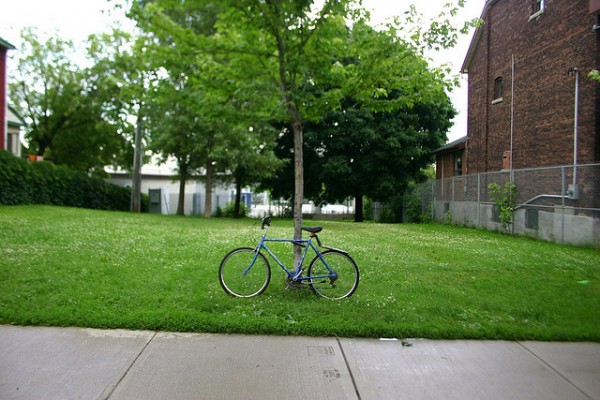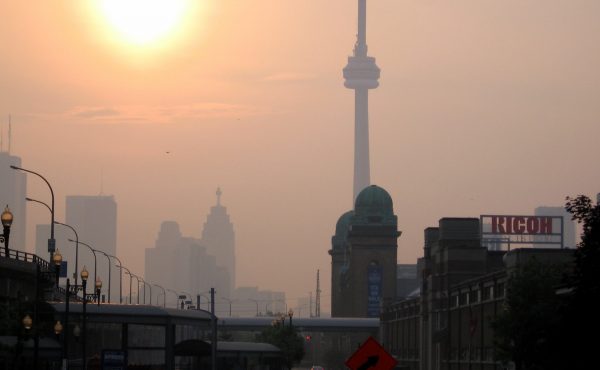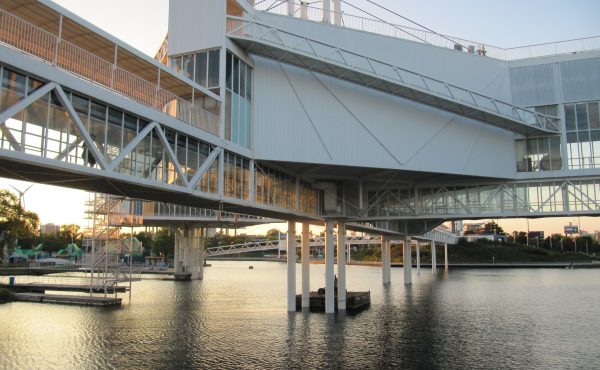

I normally have a lot of time for the Toronto Environmental Alliance, but the heat this week must have wiped out the organization’s institutional memory.
How else to explain the perplexing and conspicuous omissions on TEA’s mayoral candidate environmental report card [PDF], released yesterday.
For those who missed the evening news, Joe Pantalone comes out with solid grades, while George Smitherman gets frowny-cons and a rather catty put down (“needs to apply himself”) in the comment section.
A little background on both is definitely in order:
Pantalone, it’s true, has wrapped himself in the tree advocacy role for years. Whether this title has actually led to more trees being planted in Toronto is an untested proposition – municipalities plant constantly – and he certainly didn’t do much to ameliorate the plight of the thousands of pencil-neck trees that continue to die miserable deaths on our sidewalks.
TEA gives him a smiley face on the 70% diversion goal question, but neglects to note that council has missed this target, as well as David Miller’s 2010 deadline, by a wide margin (residential diversion is at 46%, up from 40% in 2005). Pantalone was deputy mayor the whole time. Should he not be held to account for that failure?
Most problematically, Pantalone for years advocated the construction of the Front Street Extension, the last of Metro’s downtown highways, and a megaproject that Jane Jacobs strenuously opposed. It would have ruined the Spadina/Wellington/Front/Liberty Village area, and only died because the cost became completely untenable. If I were an environmentalist, I’d certainly dock him marks for that.
And what about Smitherman? “George,” TEA sniffs, “likes to talk about the environment, but his enthusiasm doesn’t match his work to date” [emphasis added].
Excuse me? Is this the same guy who, after taking over the Energy and Infrastructure portfolio, spent the summer of 2008 touring Europe to find out how countries like Denmark and Germany use green energy incentives to build green industries that create green-collar jobs?
Is this the same guy who asked environmental groups to publicly push him to tear up Ontario’s antiquated energy policies in favour of legislation that is considered to be absolutely cutting edge in North America?
And is this the same guy who had the guts to hit the eject button when the nuclear industry and all its Liberal lobbyists were pushing for huge sums to jump start yet another reactor extravaganza?
Shortly before Smitherman tabled the Green Energy Act, one environmental activist told The Toronto Star (Feb. 11, 2009), “The idea of a Green Energy Act that speeds up the development of renewable energy is absolutely necessary.”
That quote, by the way, comes from TEA executive director Franz Hartman, and The Star, in fact, reported that TEA “applauds the legislation.”
So let’s not pretend that Smitherman doesn’t have a rock solid track record on the environment. TEA knows it, and they need to be a lot more straightforward in their political judgments if they want to retain their credibility as green watchdogs.
photo by Laurie McGregor





19 comments
John did you get a chance to read the expanded reasoning with sources not written in the teasing language?
You can see it here:
http://torontoenvironment.org/voteto/priorities/reportcard/expanded#smitherman
On the 6 Environmental Priorities:
1. Build Transit City and Fund It:
Smitherman supports transit expansion but does not support the Transit City Light Rail Plan. He favours subways over some of the Transit City lines and therefore does not have a plan that will deliver public transit to all of Toronto now.
2. Achieve 70% Waste Diversion by 2012:
Smitherman has said that he would hire a Scientific and Technical advisor to help discover new ways of reducing the waste heading to landfill, also suggesting he may consider incineration as a possible means of waste diversion. The use of incineration as a way to reduce landfill has serious health and enviromental implications, and could greatly harm both people and the environment in the process. Though Smitherman has also mentioned the need to implement a blue and green bin strategy in apartment buildings, he has stated no real target or timeline.
3. Buy and Support Locally-Produced Green Products:
No mention
4. Build Transportation Infrastructure Everyone Can Use:
Though Smitherman supports the implementation of an integrated bike strategy, he does not support a true Complete Streets policy, or the Toronto Bike Plan. Smitherman would like to see bike lanes on secondary roads coupled with separated curb lanes, but he believes that dedicated bike lanes should not be on arterial roads.
5. Implement the City’s Sustainable Energy Strategy:
Smitherman understands the importance of reducing energy consumption, green power and creating new green jobs and economic activity. He also sees Toronto Hydro as an essential asset to help achieve the Sustainable Energy Strategy. Smitherman says that he will not sell Toronto Hydro as a way of reducing debt.
6. Provide Tools to Prevent Pollution:
No mention
—-
Did you get a chance to read our priorities where we acknowledge the city’s original goal was 2010? We are measuring candidates on their platforms and commitments in this election, not the past, in relation to our 6 priorities.
From our website:
http://torontoenvironment.org/voteto/priorities#waste
The City pledged to reach 70% waste diversion by 2010 but they only made it to 50%. The key culprit in missing the target was unacceptable delays in getting the Green Bin program into high-rise buildings. This means half of Toronto’s households still don’t have access to organic waste collection services. The delays also mean organic waste continues to take up precious landfill space. Achieving the 70% target will only happen when all Torontonians have equal access to the City’s waste collection services.
Action: The next Council must ensure that all apartment buildings in Toronto have Green Bin collection service by the end of 2011. One year later, other waste diversion programs must be in place so that the City meets its 70% diversion target by 2012.
Well said John. I could probably have predicted TEA’s preferences without the help of the World Cup Octopus.
John, you’re really out to lunch here. TEA was pretty straightforward and contrary to your lame insinuation, TEA gave candidate Smitherman a simley face on energy, notwithstanding the Samsung boondoggle. Smitherman’s work to date is pretty sketchy on transit. He’s the guy that didn’t want to fund Toronto’s new streetcars and supported the McGuinty Transit City cuts. Smitherman’s support for incineration, and his Rossi-echo rhetoric against bike lanes on major streets are serious causes for concern and TEA was right to point that out. John, you call this a rock solid record on the environment? Just because you used to write for the Toronto Sun?
John is correct that TEA did NOT consider the past performance of candidates in our report card. That’s because this report card was never intended to look at past performances. Rather, it is about what candidates have said (or not said) about 6 priority actions we identified back in February (for details about the sources we used for our evaluation and the priority actions, please visit http://www.torontoenvironment.org/voteto).
TEA’s mid-campaign report card provides one snap shot of the top 5 candidates approach to the environment. Like any report card, it identifies what will be evaluated and then does the evaluation. We chose to use our 6 priority actions that we and 40 other groups believe must be implemented by Toronto’s next Mayor to build on 10 years of environmental progress in Toronto. We also chose an approach that treated everyone equal by discussing what they have said since becoming candidates.
John obviously wanted us to focus on the past performance of candidates. If any one were to do so, they would face huge methodological problems. For example, how do you compare candidates who have never held political office to candidates who have held office? How do you compare the actions of former cabinet ministers to City Councillors? What issues do you compare them on? The short answer is judging candidates on their past performances is difficult and fraught with partisan danger.
TEA prides itself for being a non-partisan organization. We have a responsibility to our members and Torontonians to produce well-researched, well-documented work that is not biased.
This report card continues this 21 year tradition. It may not show the complete picture of the 5 mayoral candidates, but the picture it does show is accurate and fair.
John, did you read the full report and background information or just look at the visuals?
TEA ranked the candidates performance at the mid-campaign point. Deliberately this report card did not get into the past performance / history of the candidates. The mid-campaign report card only ranks the candidates on the 6 Environmental Priorities that TEA and ~40 other groups endorsed as important environmental actions for Torontonians to consider when thinking about who to cast their vote for.
This means TEA stayed away from issues like the Front Street Extension, the $1 Billion E-Health scandal, racial slurs, and a whole host of other past transgressions of the 5 top mayoral candidates. Plain and simple this report card is about candidate’s performance in THIS campaign to date. Please review:
http://torontoenvironment.org/voteto/priorities/reportcard
for more information on rationale behind the mid-term performance of each candidate.
To call this report “greenwashing” demonstrates a lack of critical thought and understanding of the key green issues facing Toronto today. I’d assumed someone of your experience, intelligence and history would be able to see this.
Here’s hoping you can find a way back on the same page with TEA and work together to elect the most environmentally-sound Mayor and Council on October 25th.
For the record, Smitherman’s ‘eject button’ on nuclear was late in the game. He was pretty cool with promoting and flagging $40+ billion for nuclear power and some change for conservation and renewable power. Recall scary phrases of ‘Onrtario going dark.’
The context of ‘Eject’ included federal wavering on Canada’s nuclear future (Chalk River, CANDU) plus the overrun *estimates* were already getting out of control & the industry was making no assurance to contain them or share in the expense.
Consumption also dropped significantly (even before the recession started) and OPG’s newest Need Forecasts indicates Ontario’s consumers might not need the extra nuclear juice. That said, demand & events south of the border might bring the ‘need’ for nukes back.
Smitherman may be speaking renewable now but don’t discount the external factors. He was an industry champion before and would likely resume that role under the right circumstance.
When you calculate what the Green Energy Act will cost the province in the long run, it is really quite astounding. Things like eHealth and the 407 seem trivial by comparison. From an environmental perspective it may at first seem like a step forward, but achieving any sort of economic payback on solar and wind is next to impossible in our climate. This casts the environmental benefit in serious doubt as well.
Ontario is burning coal and gas right now to meet demand every day. We should have started nuclear build years ago and had it built by now. We could have actually be doing something for real about our carbon emissions. Smitherman is directly at fault for this. Windmills and solar panels are worse than a joke: they are a scam.
Hot damn…it would seem that members of the TEA read Spacing and don’t have a problem commenting under several aliases and perhaps one real name. Guess you struck a nerve, John.
Most importantly, our next mayor needs to get elected first, which is why most people take campaign promises with a grain of salt, since they are more likely to reflect the perceived views of voters, rather than the candidate.
Past performance while in office is the best criterion for evaluating any candidate’s values with respect to the environment. It is bizarre that TEA would treat campaign performance as more significant than actual accomplishments.
To quote the Toronto Environmental Alliance
“1. Build Transit City and Fund It:
Smitherman supports transit expansion but does not support the Transit City Light Rail Plan. He favours subways over some of the Transit City lines and therefore does not have a plan that will deliver public transit to all of Toronto now.”
That’s laughable! All of Toronto has public transit NOW! You don’t need to support a billion dollar plan to upgrade some bus routes to light rail. He has an alternative plan which is imperfect, but it’s a rather largescale plan.
The Toronto Environmental Alliance seems very ignorant and narrow-minded on this issue, basically assuming that if the transit plan isn’t Miller/Giambrone’s sacred cow, then it’s not a good plan. Our subway lines are becoming so packed that relief is desperately needed in the form of new lines. The significant density of our suburban areas and the ridership of surface routes would easily make at least one suburban east/west subway line very successful and encourage further density. (Heck, even the stubway matches the King car’s ridership despite being so much of a shorter line and not passing through downtown’s densest area.)
Come on, get off your bicycles and offer some real insight on transit, Toronto Environmental Alliance!
“The significant density of our suburban areas and the ridership of surface routes would easily make at least one suburban east/west subway line very successful….”
Not really. There isn’t the density at all in the burbs. And subways require a multiplicity of destinations, within a reasonable distance of stations.
That’s where you’re ignorant, Cervante. The suburban 416 has clusters of high density. It’s a good part of the reason why we’re second only to NYC in terms of high-rises. Our suburbs are filled with high-rises and plenty of midrises.
A suburban subway in Toronto would have plenty of destinations from nodes of employment and residential density to campuses, commercial areas, the airport, etc.
A.R., Cervantes is correct. Density (population) is a poor indicator of the ability of PT to be utilized. From Lawrence D. Frank and Gary Pivo. Impacts of mixed use and density on utilization of three modes of travel: single-occupant vehicle, transit, and walking. Transportation Research Record, 1466:44-52, 1994
As per the analysis from David Pritchard….
“Overall, the most interesting result of the paper is the
demonstration of nonlinearity. Figures 2 and 3 of their paper show
a graph of modal share vs. employment density, and vs. population
density. These graphs show that major increases in bus/walk modes
only happen at employment densities greater than 125
employees/acre (work trips), or 13 residents/acre (shopping trips).
The implications for policy are obvious: if you aren’t going to
reach those thresholds, you’re wasting your time. Also, the
employment graph shows substantial nonlinearity: between 75 and 125
employees/acre, there is essentially no change in mode share.
They also had some predictable results: walking trips were the most
sensitive to increases in population density; it’s worth
considering densities at both trip ends (i.e., both residential
population density and employment population density); etc.”
Well, Glen, you start off by challenging me but you don’t apply the information you quote to the discussion at hand. I’m not sure why you bothered to post a useless comment like that unless you’ve adopted spamming as a means of self-promotion.
A.R. you called Cervantes ignorant based on your assertion that the 416 had the density and destinations required to support subway expansion. Yet Toronto’s density and growth do not fit the requirements to support transit expansion.
That’s it? The entire city doesn’t have the density? Are you sure you’re not thinking of Toronto, Ohio?
A.R.,are you intentionally missing the point. Residential density does not drive PT ridership. The employment dense areas of Toronto already have subways. So saying “our suburbs are filled with high-rises and plenty of midrises”, as proof of having the requisite ridership to support subways is wrong. Patently so. As any decent research shows, including the TTC’s own figures, ridership follows employment trends, employment density, and gas prices more than population density.
“As any decent research shows, including the TTC’s own figures, ridership follows employment trends”
As Steve Monro noted, much to the TTC’s surprise, ridership has continued to grow dispute the the rise in unemployment and the fare hike.
He points out “that employment losses have been disproportionately in the suburbs where transit modal split is low.”
Darwin,
The TTC should not have been surprised. The relationship diverged starting in 2003, coinciding with escalating oil prices. The same trend is seen throughout NA.
The point I have been making, and echoed by the TTC is that factors determining ridership are exogenous to them. Population density while relevant is low on the list. The main factor is the destination, which is why relying on continued growth in the face of rising unemployment in Toronto, is foolish. The traditional relationship between employment and ridership may have diverged but it is not severed. Ultimately it will set the upper-bound of ridership potential.